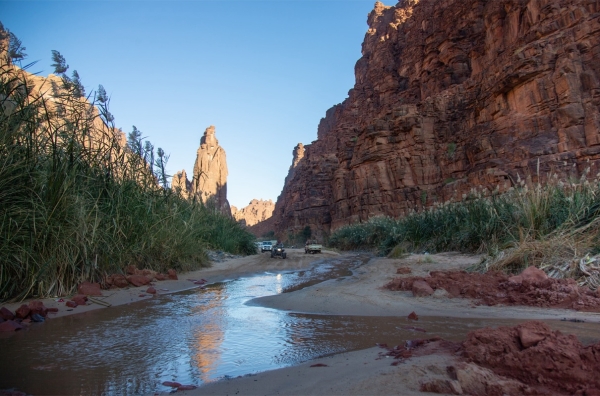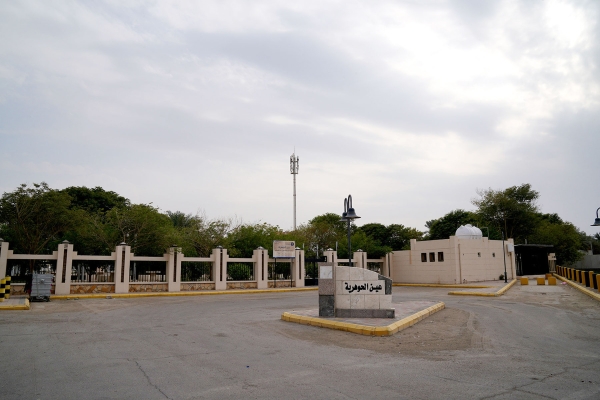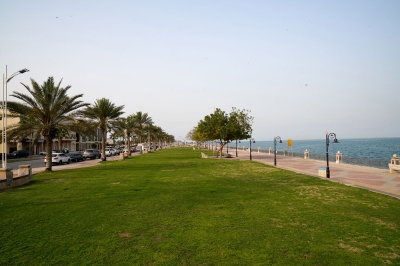

The Springs in the Kingdom of Saudi Arabia are one of the water sources in the Kingdom. Several springs of historical significance to residents and travelers have been discovered, most of which are concentrated in the Arabian Shield west of the Kingdom due to its sedimentary layers and groundwater reserves. The southwestern springs in as-Seeh area (at the Kingdom's center) are among the most notable, characterized by their abundant waters and unique basins.
Concept of water springs
Springs are spots where groundwater naturally flows out of the earth. Spring water originates from rainfall that seeps into porous soil and rock layers, such as limestone and sandstone, where it is stored as part of the groundwater system. This water then travels through cracks and fractures and becomes confined between two layers. Spring water flows from a higher elevation above the ground to a lower elevation, emerging in various forms. Based on their water temperature, springs can be classified into several categories.
Types of springs in Saudi Arabia
The various types of springs in the Kingdom are divided into two main categories. The first category is natural springs, suitable for drinking and irrigation. The mineral composition of these springs varies depending on the rock layers surrounding the water. These springs are found in both the eastern and western regions of the Kingdom.
The second category is hot springs, primarily found in the western regions of the Kingdom, where Harrat volcanic fields are prevalent. These springs are mainly located near the Harrat volcanic fields along the Red Sea. Rainwater seeps through cracks in the earth's surface, reaching the core and accumulating near magma chambers. The heat from the magma warms the water, causing it to rise to the surface through fissures under pressure.
Benefits of springs in Saudi Arabia
The springs in the Kingdom have various and distinct benefits. Mineral waters are rich in numerous minerals that significantly benefit the body and brain, as the body can quickly and effectively absorb dissolved minerals from water. These minerals include magnesium sulfate, calcium, sodium, potassium, and chloride sulfate.
Hot springs are known for their ability to relieve tension. The minerals present stimulate the healing process by relaxing muscles, alleviating pain, and aiding in the cleansing of the skin. They also treat eczema, psoriasis, and other skin diseases.
Names of springs in Saudi Arabia
Springs are scattered in different regions of Saudi Arabia, including:
Ain al-Jobah Spring: Located at the heart of al-Jobah in Wadi ad-Dawasir Governorate, affiliated with the Emirate of Riyadh Province, the spring is characterized by its extreme heat and attracts tourists for therapeutic purposes due to its sulfur content. It is known for treating certain skin diseases and rheumatism and for dilating blood vessels in the body.
Zubaidah Spring: It is located in Jabal Tad between Taif and Makkah al-Mukarramah. It is a rich water spring originating from Wadi Uthman, flows through Mount Arafat, crosses Wadi Orna to al-Khutam, and then descends to Mina, eventually reaching Makkah al-Mukarramah. In ancient times, it was considered the central water source for the people of Makkah al-Mukarramah.
Jazan Springs: They are located in Jazan, south of the Kingdom, and consist of about six springs, some with cold mineral water and others with hot water, including al-Ain al-Harra in Bani Malik.
Ad-Dil' Spring: It is located southwest of as-Seeh City in al-Kharj Governorate, affiliated with the Emirate of Riyadh Province. With a depth of thirty m, it is one of the prominent springs in the Kingdom and is distinguished by its clarity, allowing the rocks to be seen through the water. As-Seeh includes several sulfuric mineral springs that have been significant since ancient times, such as Ain Samhah, Ain Umm Khisah, and Ain Farzan, north of As-Seeh.
Thee Ain Spring: Located in the historic Thee Ain Village in al-Bahah Province, south of the Kingdom, the spring is distinguished by its origin from the highest mountain peaks and descent into several valleys.
Ain al-Jawharea Spring: It is located in al-Battaliyah Village in al-Ahsa Governorate, east of the Kingdom. The spring is one of the historically significant tourist sites known for its fresh and cool waters. The flow of Ain al-Jawhareah Spring is estimated at twenty thousand gal/m, with its water reaching the surface through three outlets, forming a large lake.
Ain Mousa Spring: Located in Wadi Magna in Tabuk Province, northwest of the Kingdom, these ancient springs originated from the heart of the sands, gaining Magna great popularity.
Wadi at-Tayyeb Spring: This spring is situated in Wadi at-Tayyeb in Tabuk Province and flows into the Gulf of Aqaba. It is famous for its sedimentary and rocky layers and the varying quality of its water from year to year. It is regarded as one of the natural wonders of Tabuk and a prominent tourist destination.
Wadi ad-Disah Spring: This spring is located in the agricultural ad-Disah Village in al-Ula, northwest of the Kingdom, within an area made up of sandstone and basaltic lava. The source of one of the springs in the valley's center is unknown, as it flows from a rocky spot.
NASA's discovery of springs in Saudi Arabia
In 2012, the United States space agency, the National Aeronautics and Space Administration (NASA), announced the discovery of new springs in the heart of the desert in the Kingdom. NASA used a combination of wavelengths to capture four images that revealed the existence of agricultural fields extending for about one km, marked in green. These green fields were discovered to contain stored water from the Ice Age and rainwater that had accumulated over hundreds of thousands of years. These ancient water-filled groundwater layers were buried under the shifting desert sands. The Kingdom was able to uncover it through excavation work in the sands.
Related quizzes
Related articles


